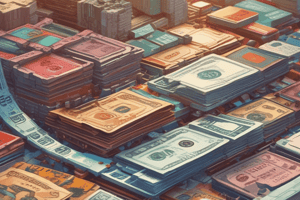Podcast
Questions and Answers
What is the formula to calculate the mean in statistics?
What is the formula to calculate the mean in statistics?
The mean is calculated by adding all observations and dividing them by the total number of cases.
Explain the concept of median in statistics.
Explain the concept of median in statistics.
The median is the middle value when arranging data from smallest to largest.
How is the mode defined in statistics?
How is the mode defined in statistics?
The mode refers to the value that appears most frequently within a dataset.
What role do descriptive statistics play in economics?
What role do descriptive statistics play in economics?
How do regression analyses contribute to economic decision-making?
How do regression analyses contribute to economic decision-making?
What are some common techniques used in time series data analysis for forecasting future events?
What are some common techniques used in time series data analysis for forecasting future events?
Explain the Lucas Critique and its impact on forecasting models.
Explain the Lucas Critique and its impact on forecasting models.
How do economists account for temporal patterns in economic data when making forecasts?
How do economists account for temporal patterns in economic data when making forecasts?
Why is sampling crucial in statistical analysis, and what are some common sampling methodologies?
Why is sampling crucial in statistical analysis, and what are some common sampling methodologies?
How do advanced computational tools expand the capabilities of economists beyond linear regression models?
How do advanced computational tools expand the capabilities of economists beyond linear regression models?
Flashcards are hidden until you start studying
Study Notes
Exploring Economy with Statistical Analysis Techniques
Understanding our economy's dynamics isn't just about crunching numbers; it also involves extracting valuable insights through data analysis methods. This essay will explore some of these essential statistical techniques used by economists and their impact on shaping economic decisions.
Central Tendency Measures
In economics, we often look at central tendency measures such as mean, median, and mode. The mean is calculated by adding all observations and dividing them by the total number of cases. On the other hand, the median falls right smack in the middle when arranging values from smallest to largest. Lastly, the mode refers to the value appearing most frequently within a dataset. These measures help us understand where the bulk of data lies—be it skewed towards one side or symmetrical around its centerline.
Descriptive Statistics
Descriptive stats give a general idea of how data looks like without making any assumptions. We use measures such as range, interquartile range, variance, standard deviation, skewness, kurtosis, and correlation coefficients to gauge features like variability, spread, shape, and relationship between variables. For example, comparing average income across different countries helps us identify whether certain regions have more equal distribution of wealth.
Regression Analyses
Regression analyses describe the relationship between two quantitative variables. By fitting a mathematical model using historical data points, economists forecast future trends based on changes in independent variable(x) values while holding others constant. Linear regression models are popular among researchers because they offer simplicity and predictable outcomes. However, advanced computational tools allow us to go beyond linearity to tackle nonlinear relationships and even time series data.
Time Series Data & Forecasting
Economic indicators change overtime due to numerous reasons, including seasonal patterns and cyclical fluctuations. To account for this temporal dimension, economists collect data points sequentially forming time series datasets. They leverage autocorrelation, moving averages, exponential smoothing, and ARIMA modeling to make predictions of future events with varying levels of precision. Although these techniques can help formulate hypotheses, they might fail under specific conditions—a well-discussed pitfall known as the Lucas Critique.
Sampling Methodologies
Sampling is crucial for estimating population parameters using a subset called sample data. There exist various approaches, each bearing unique advantages and disadvantages. Some common sampling strategies include simple random, stratified, cluster, systematic, convenience, snowball, and quota samples. Each method has its place depending on budget constraints, available resources, and level of accuracy desired.
Learning statistics doesn't only equip you with technical skills needed to analyze data effectively, but it also encourages critical thinking, problem solving, and creativity—valuable abilities necessary in today's rapidly changing world. As economies evolve, so does our need for adaptive and efficient analytical methods to guide strategic decision-making.
Studying That Suits You
Use AI to generate personalized quizzes and flashcards to suit your learning preferences.




